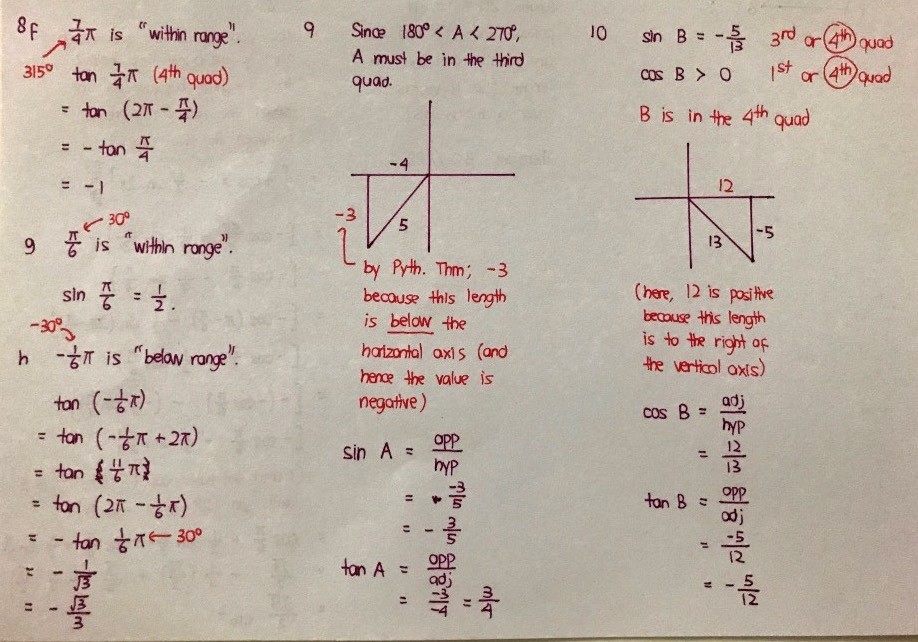Eric Nicholas K's answer to LockB's Secondary 3 A Maths Singapore question.
done
{{ upvoteCount }} Upvotes
clear
{{ downvoteCount * -1 }} Downvotes
Q8f to Q10
Date Posted:
3 years ago
i dont understand 8e-h as i have not learn radian measure yet. can you help me with radian measure? thx :)
In this radian measure topic, you will learn to measure angles in the radian form.
For a unit circle of radius 1 unit, you will notice that the circumference of the circle is 2pi x 1 = 2pi units. So, if a point lies on the circle, it will have travelled 2pi units before returning to the same point. The point would have covered an equivalent angle of rotation of 360 degrees.
Hence, we can relate this equivalence, in angle terms, as
2pi radians <====> 360 degrees
Simplifying,
pi radians <====> 180 degrees
To convert from degrees to radians, we divide the degree angle by 180, then multiply a pi to it.
To convert from radians to degrees, we multiply our angle by 180, then divide by pi. If pi was already present in the radian form, we simply remove the pi at the end.
So, for example, pi/2 radians translate to 90 degrees, while pi/6 radians translate to 30 degrees. Similarly, 450 degrees translate to 5pi/2 radians, while -45 degrees translate to -pi/4 radians.
You can try translating the following to the equivalent other form.
1. 270 degrees
2. 120 degrees
3. 720 degrees
4. -10 degrees
5. pi/9 radians
6. 2pi/5 radians
7. 10pi radians
8. 2 radians
Your calculator has a radian form as well, and you can convert between forms as well. If you are using Casio fx 96 SG Plus, you can press SHIFT —> MODE/SET UP. You will see a selection 3: Deg and 4: Rad. Selecting 3 will set your calculator to degree form, while selecting 4 will set your calculator to radian form. It is important to know what form your angles in each question take, because the modes will affect the computation of sin, cos and tan.
For example, the equivalent of 180 degrees is pi. If you type sin 180 when your calculator is in degree form, you will get an answer of 0. If you type sin pi when your calculator is in radian form, you will get an answer of 0. However, if you type sin 180 when your calculator is in radian form, or sin pi while your calculator is in degree form, you will get an incorrect answer. So, you will need to choose the correct settings for your calculator.
For a unit circle of radius 1 unit, you will notice that the circumference of the circle is 2pi x 1 = 2pi units. So, if a point lies on the circle, it will have travelled 2pi units before returning to the same point. The point would have covered an equivalent angle of rotation of 360 degrees.
Hence, we can relate this equivalence, in angle terms, as
2pi radians <====> 360 degrees
Simplifying,
pi radians <====> 180 degrees
To convert from degrees to radians, we divide the degree angle by 180, then multiply a pi to it.
To convert from radians to degrees, we multiply our angle by 180, then divide by pi. If pi was already present in the radian form, we simply remove the pi at the end.
So, for example, pi/2 radians translate to 90 degrees, while pi/6 radians translate to 30 degrees. Similarly, 450 degrees translate to 5pi/2 radians, while -45 degrees translate to -pi/4 radians.
You can try translating the following to the equivalent other form.
1. 270 degrees
2. 120 degrees
3. 720 degrees
4. -10 degrees
5. pi/9 radians
6. 2pi/5 radians
7. 10pi radians
8. 2 radians
Your calculator has a radian form as well, and you can convert between forms as well. If you are using Casio fx 96 SG Plus, you can press SHIFT —> MODE/SET UP. You will see a selection 3: Deg and 4: Rad. Selecting 3 will set your calculator to degree form, while selecting 4 will set your calculator to radian form. It is important to know what form your angles in each question take, because the modes will affect the computation of sin, cos and tan.
For example, the equivalent of 180 degrees is pi. If you type sin 180 when your calculator is in degree form, you will get an answer of 0. If you type sin pi when your calculator is in radian form, you will get an answer of 0. However, if you type sin 180 when your calculator is in radian form, or sin pi while your calculator is in degree form, you will get an incorrect answer. So, you will need to choose the correct settings for your calculator.
btw what is theta(in radians) = s/r about tho, i saw it in my textbook but have no idea what does it mean
for converting degree to radian, when we type into the calculator we will get number instead of the radian form tho
for example i will get 7.85...... instead of 5pi/2
is there a way to get the answer in radian form?
for example i will get 7.85...... instead of 5pi/2
is there a way to get the answer in radian form?
That formula,
s = r theta,
is a formula for calculating the length of a circular arc when the angle used is in radian form. Its equivalent format in the degree form is
s = theta/360 times 2pi r, which is basically an angle proportion of the entire circumference of a circle. So, if you chop off a circle into two equal parts, you will expect the arc length of each portion to equal pi r units long.
In radian form, 180 degrees is equivalent to pi radians. With a radius r units, the arc length is s = r theta, or r times pi, which is the same as the degree form.
You will need to master this radian form of the angle as it is very frequently used in A Maths.
s = r theta,
is a formula for calculating the length of a circular arc when the angle used is in radian form. Its equivalent format in the degree form is
s = theta/360 times 2pi r, which is basically an angle proportion of the entire circumference of a circle. So, if you chop off a circle into two equal parts, you will expect the arc length of each portion to equal pi r units long.
In radian form, 180 degrees is equivalent to pi radians. With a radius r units, the arc length is s = r theta, or r times pi, which is the same as the degree form.
You will need to master this radian form of the angle as it is very frequently used in A Maths.
"for converting degree to radian, when we type into the calculator we will get number instead of the radian form tho
for example i will get 7.85...... instead of 5pi/2
is there a way to get the answer in radian form?"
------------------------------------
That is a good question. Some newer models of calculators are able to express a value as 2 pi, for example, whereas most calculators will only provide the decimal form.
One way to overcome this is to avoid the use of pi as we enter the values into the calculator. For example, converting 720 degrees to radians gives us 4 pi radians. The conversion requires us to multiply the degree version by pi/180 to get the radian form; however, in practice, we just key in 720 x 1/180 rather than 720 x pi/180 to get a value of 4 before we manually multiply the value by pi to get 4pi. This is to avoid seeing decimals due to the 4pi expression.
Another way is to familiarise yourself with common decimals for values of pi, especially pi, 2pi, pi/2, pi/3, pi/4 and pi/6.
for example i will get 7.85...... instead of 5pi/2
is there a way to get the answer in radian form?"
------------------------------------
That is a good question. Some newer models of calculators are able to express a value as 2 pi, for example, whereas most calculators will only provide the decimal form.
One way to overcome this is to avoid the use of pi as we enter the values into the calculator. For example, converting 720 degrees to radians gives us 4 pi radians. The conversion requires us to multiply the degree version by pi/180 to get the radian form; however, in practice, we just key in 720 x 1/180 rather than 720 x pi/180 to get a value of 4 before we manually multiply the value by pi to get 4pi. This is to avoid seeing decimals due to the 4pi expression.
Another way is to familiarise yourself with common decimals for values of pi, especially pi, 2pi, pi/2, pi/3, pi/4 and pi/6.
for 8h why after adding 2pi to - 1/6pi then we must do tan(2pi-1/6pi) tho
btw do we always have to add 2pi to the value if the value is below range?
btw do we always have to add 2pi to the value if the value is below range?
2pi-1/6pi is an angle 11pi/6, which is a fourth quadrant angle within the cycle range, whereas -1/6 pi is a fourth quadrant angle which is below range. For angles below range, we must keep adding 360 (or 2pi if radians) until you get an angle in range.
otger adding 2pi to make the value in range we see which eqn to use based on which quadrant does the angle lie in?
eg 2nd quadrant pi- value
3rd quadrant pi + value
or is it another type of eqn used here for the 2pi-....
eg 2nd quadrant pi- value
3rd quadrant pi + value
or is it another type of eqn used here for the 2pi-....
Once you have added or subtracted 360 (2 pi if radians) to meet the necessary range, we proceed to determine the quadrant it is in.
Then the usual rules apply for the quadrant
If your angle is in the first quadrant, then it is related to basic angle by x = alpha.
If second quadrant, x = 180 - alpha.
If third quadrant, x = 180 + alpha.
If fourth quadrant, x = 360 - alpha.
Then the usual rules apply for the quadrant
If your angle is in the first quadrant, then it is related to basic angle by x = alpha.
If second quadrant, x = 180 - alpha.
If third quadrant, x = 180 + alpha.
If fourth quadrant, x = 360 - alpha.
For example,
1575 is 3 x 360 + 135.
So, 1575 is in the same position as 135 which lies in the second quadrant and has a basic angle of 45.
sin 1575
= sin (4 x 360 + 135)
= sin 135
= sin 45 (since sine in the second quadrant is also positive just like sin 45)
= 0.5 times ./2
1575 is 3 x 360 + 135.
So, 1575 is in the same position as 135 which lies in the second quadrant and has a basic angle of 45.
sin 1575
= sin (4 x 360 + 135)
= sin 135
= sin 45 (since sine in the second quadrant is also positive just like sin 45)
= 0.5 times ./2



